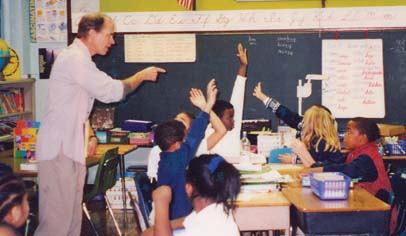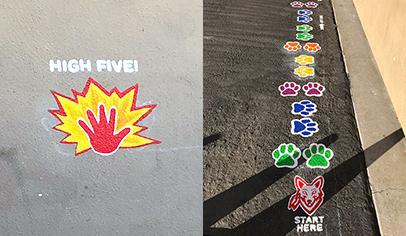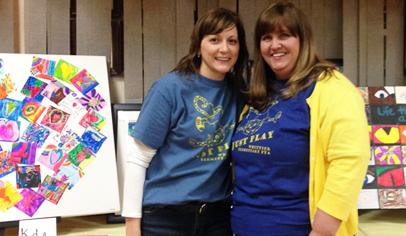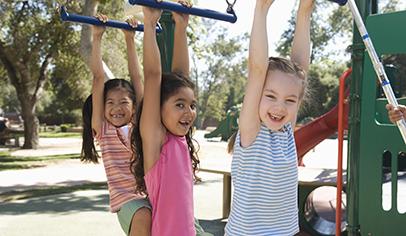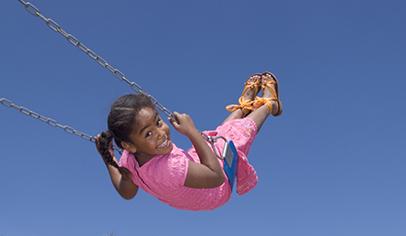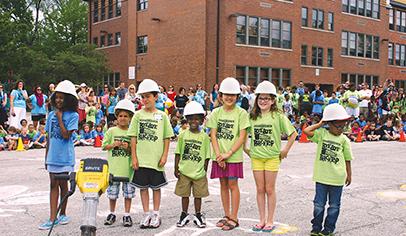Ask a group of parents to design a school playground and they’ll explore safety issues from top to bottom and find the best prices on playground equipment. Ask a group of kids to design a playground and they’ll draw castles, dinosaurs, and gravity-defying slides that plunge into shark-infested waters.
In the midst of playground committee meetings and sales pitches, it’s easy for adults to lose sight of the kids’ perspective. But when a parent group is spending thousands of dollars, it pays to consult the experts—the very kids who have climbed, hung upside down on, and slid down equipment on every playground in the neighborhood.
Involving kids in the process can be as easy as polling students or as involved as holding a student focus group with a playground designer. Here’s how a few enterprising schools involved kids in their playground projects.
Put Imaginations to Work
Mesita Elementary School in El Paso, Texas, found a way to involve all of its 550 students in designing its new playground. Building a new playground was a priority for the PTO, as the old metal equipment became too hot to use many days of the year. The PTO turned to KaBOOM, a Chicago-based nonprofit, to help it fund and build the playground.
Students designed their dream playgrounds and submitted the plans to KaBOOM project manager Kristina Saleh in two hour-long assemblies. Rather than give students catalogs and pictures to look at, Saleh encourages students to let their imaginations run wild.
Saleh picks up on themes in the drawings and tries to incorporate similar play activities into the design. If a lot of kids ask for a trampoline, she works a place for kids to jump or a bouncing piece of equipment into the design. If kids stress that the slides in their drawings are really tall, she makes sure the new slide is taller than average. “There are always one or two things that come out that the parents are surprised about,” Saleh says.
Parents may initially be alarmed by the pictures children draw of towering rock walls, but instead of saying no to the idea, they should try to work a safe climbing surface into the plans, she says.
At Mesita Elementary many students drew pictures of swings, which are not allowed by the school district. Other features suggested by students were included in the plans, giving them a sense of ownership.
The student whose drawing most closely resembled the final design was recognized, and his drawing was printed on a T-shirt made by the project’s corporate sponsor, a local grocery store, according to Ann Horak, the Mesita Elementary PTO member who coordinated the playground project. Horak’s third grade daughter drew a monorail, which was incorporated into the final design.
Involving students in design has long-term benefits. The students know they’ve been listened to and they have a more exciting place to play. That sense of ownership translates into less vandalism on the playground, designers say.
Involve Kids in Every Step
During the assemblies at Mesita Elementary, Saleh led the students in making rules for the new playground. The number one rule the kids came up with? Have fun. If someone is pushing another person off the slide, then someone isn’t having fun, so pushing is not allowed on the playground.
Parents constructed the playground under Saleh’s supervision in April. Involving students and parents in the design and installation of new playground equipment turned into a bonding experience, Horak says.
The elementary students, who were not part of the build for safety reasons, met in the school and created cutouts of their traced hands on construction paper. Stapled together, the hands made a ribbon for the playground’s ceremonial ribbon cutting. Students also made thank-you banners for KaBOOM and the corporate sponsor.
Junior high students who had attended Mesita Elementary pitched in by painting hopscotch and four-square patterns on the blacktop.
“The kids had such a great time and the adults had such a great time that we’re going to implement an annual playground work day,” Horak says.
Students will also help with upkeep throughout the school year. Each month students in the third, fourth, or fifth grade will rake the wood chips.
Photos of the build were placed on a school bulletin board, where students pointed out their moms and dads at work to their classmates.
Conduct an Informal Poll
Even if your school is not working with a playground designer, there are easy ways to involve kids in the design process. In Arlington, Va., teachers and parent leaders at Barrett Elementary School solicited input from students when the school needed new playground equipment.
The school’s playground closed when construction on a new classroom wing started. During construction students hiked a short distance to a nearby city park for recess. Students provided reviews of the park’s equipment and named items they would like to have on the school playground.
Students wrote comments and drew pictures of what they wanted on their new playground, showing a variety of slides, such as spiral slides and covered slides, and lots of swing sets. Some drawings and opinions were featured on the school’s Web site.
Fourth-grader Selina wrote that she likes going to the park for recess, but too many people want to play on the tire swing. “A lot of people want to go on the tire swing,” she wrote. “When they don’t get a chance to go on the swing, they get all mad at each other.”
Anne Steen, who served as the school’s PTA president in 2001-2002 and 2002-2003 school years, polled her children’s friends and the children at the bus stop and compared notes with parents at PTA meetings. Steen’s son, a third-grader at Barrett Elementary, wanted old-fashioned monkey bars, which were eventually incorporated into the new playground. Her daughter, now in middle school, wanted to be sure that the previous layout, a tot lot for younger kids and a larger play structure for older kids, would be duplicated. It was.
Let Kids Lead
To make sure it involved kids in every step of its playground project, Houston Elementary School in Philadelphia formed a children’s committee, with students from each classroom. The children’s committee, which had students from kindergarten through eighth grade, led student involvement in the playground project, including raising money with a school coin drive and a talent show.
In addition to providing input to the playground designer, some students spoke to community groups to solicit donations and recruit volunteers for the community-built playground. When the project was completed, students suggested names for the playground and wrote thank-you notes.
